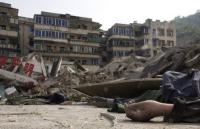Scientists comment on the Haiti earthquake
 Devastation in Port-au-Prince following the Jan. 12 earthquake. CC Photo: dailyniteowl.com
Devastation in Port-au-Prince following the Jan. 12 earthquake. CC Photo: dailyniteowl.com
The powerful 7.0-magnitude earthquake that hit Haiti on Tuesday destroyed Port-au-Prince, the capital city, and has left a death toll that may reach hundreds of thousands, according to some official reports. Rescue efforts continue.
Eric Calais, a geophysicist at Purdue University, said that Haiti’s earthquake resulted from the sudden movement of a "strike-slip fault," a horizontal motion of two tectonic plates moving horizontally and in opposite directions along a fault line. The Enriquillo-Plantain Garden Fault runs generally east-west through Haiti, to the Dominican Republic to the east and Jamaica to the west.
Several factors made the people of Haiti more vulnerable to the quake.
Pedro de Alba, PhD, a University of New Hampshire professor of civil engineering, said Haiti has the “worst possible” preparation for surviving an earthquake of this magnitude.
The earthquake was shallow -- about 10 kilometers below the surface – a type which causes the most destruction, said de Alba. It struck just 15 kilometers from the center of heavily populated Port-au-Prince, which received among the highest levels of energy release.
Stuart Sipkin, a seismologist at the U.S. Geological Survey, said a main factor contributing to the earthquake’s devastation was its size. "But then there is also the earthquake depth,” he said. “The deeper the earthquake goes, the more energy is attenuated or spread out as it goes toward the surface. This was a very shallow earthquake, which means it would tend to be more destructive. And then there's the proximity to where people live."
Another factor that made the impact worse for Haitians was the poor construction of buildings. As seen in many pictures coming out of Haiti, inexpensive to produce concrete structures are used widely throughout the undeveloped, poverty-stricken nation in homes, schools and hospitals.
Not even the presidential palace escaped collapse. “Although the city is practically on the fault that ruptured, the area had not experienced a severe earthquake for more than 100 years, so people had very little ‘earthquake consciousness’ which would translate into requiring earthquake-resistant design,” said de Alba. “This is demonstrated by the number of building collapses, including the presidential palace, which lost its whole second floor in a classic example of the ‘soft story’ effect, where internal bracing is sacrificed to leave large open spaces.”
A series of aftershocks followed Tuesday’s quake, which is typical, according to Stuart Sipkin, a seismologist with the U.S. Geological Survey. "The aftershocks will start off being fairly large and fairly frequent, and then sort of peter out as time goes on, although you will see aftershocks for weeks to months after the earthquake. They will be decreasing in size and frequency, but at this point they're still large enough to be of concern in hampering the rescue efforts."
Some of the aftershocks have exceeded a magnitude of 5 and have caused additional damage.
Many countries have pledged aid to Haiti -- for rescue efforts, temporary shelter and re-building -- in the days following the earthquake. That help is desperately needed as the nation faces a difficult and expensive reconstruction.
De Alba says new techniques have been developed for building low-cost structures that are more earthquake-resistant, but Haiti will need significant financial and technical support from other countries to adopt them. “Unfortunately, it is not only housing that will need a large investment, but also lifeline systems, as shown by near total failure of the water supply at this critical time.”



 del.icio.us
del.icio.us Digg
Digg












lost their lives and especially too all the children...god bless and hope
everything will be back to normal.
And that, of course, is by far the most important challenge..........
Incidentally, and completely off-topic, the two words in the captcha window below read "Abolished Cadences." I find that cute.
:)
whole life, so why is it still limited in the disease and poverty?
Post your comment